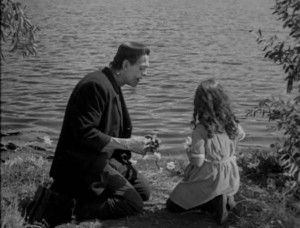(Originally posted June 6, 2008)
Now that EJ has called me out on his blog (if you ever want proof you’re not making the most out of your time on this earth, read EJ’s excellent musings as he vacations in his own city), I’m (self-)pressured to post something more thoughtful than “The Brood kicks ass!” (though, I don’t think that can be overstated). Luckily, my friend Vik gave me some grist: After reading my post on The Thing, he engaged me in an e-mail exchange aboutthe nature of monsters.Vik startedby referencing the wikipedia entry on monsters (recommended reading), and asked “Does a monster need to be inherently evil?” I’ve never tried to define what “monster” means to me, and Vik’s initial line of questioning got me thinking about formulating some sort of personal parameters for the monstrous. So, here’s what a “monster” is to me:
- A monster is a manifestation or embodiment of universal or primal fears, and engenders that emotional response when we’re confronted with it (even if we don’t always understand why). Some of the best monsters represent a number of fears simultaneously — Frankenstein’s monster embodies a fear of science, fear of the body, fear of one’s remains being desecrated, fear of the state of undeath, even a fear that one can be”born bad”(which certainly seems to be Frankenstein’s perception of his creation… But more on that later).

- Monsters threaten, harm and kill us. This can range from malicious monsters who set out to commit murder, to creatures acting on instinct, to misunderstood monsters who are driven to fight back because we leave them no other choice. It can also include monsters who are simply confused:In the 1931 film version of Frankenstein, the Monster mimics Maria, who is tossing flowers into the lake, bythrowing the girl into the water. He isn’t intent on killing her, but she seemingly drowns all the same.
- A monster does not need to be inherently evil. Are the aliens in the Alien series innately evil, or simply animals acting on instinct? I prefer the latter, yet they can still be “monsters” because they (very graphically) represent some really fundamental fears: fear of the unknown, fear of the body, fear of infection, fear of nature… I’m partial to the misguided, misunderstood, and tragic monsters myself, though the inscrutably evil monsters — those monsters who are evil without any explanation or backstory — can often be just as terrifying. Hannibal Lecter (from Silence of the Lambs, at least), the Shape in the original Halloween, and “The Man with the Scarlet Eye” (”Friend”) from Robert R. McCammon’s Swan Song are all decent examples. The fact that we don’t know what makes them tick makes these characters even more frightening.
- A monsterdoes not need to be sentient or self-aware. The base definition of a monster as the manifestation of something we all fear can easily include monsters that don’t have any recognizable consciousness or personality (and, in fact, this might be the ultimate representation of the “Fear of the Unknown” — something so alien and different that we can’t even communicate with it or recognize anything of ourselves in it). But again, the most memorable and effective monsters do seem to have at least some sort of consciousness, along with a corporeal form — they are tangible and physically present. As an example, look at the commonFear of Disease/Infection. In this case, the monster could be a disease/virus itself (The Andromeda Strain), or the contagious carrier (any flesh-eating zombie movie), or even the creator of the disease. But what’s scarier? A zombie from Dawn of the Dead, or the virus in Outbreak? There’s no right answer, but I’d tend to go with the zombie (though I’d also argue that the real monster in Outbreak is the government. Or that damn monkey).
That’s all I’ve generated thus far. Thoughts welcome.

Leave a Comment